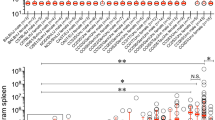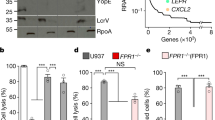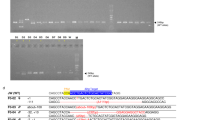Abstract
We have previously described SEG/Pas as the first mouse inbred strain able to survive subcutaneous injection of virulent Yersinia pestis, the agent of plague, and we identified Yprl1, Yprl2 and Yprl3 as three quantitative trait loci (QTLs) controlling this exceptional phenotype in females from a backcross between SEG/Pas and C57BL/6 strains. We have now developed congenic strains to further characterize the extent and effect of these genomic regions. In this study, we confirm the importance of two of these regions, both in males and females, while the third one may well be a spurious association. We show that no genomic region alone is able to increase the survival of C57BL/6 mice, but that C57BL/6 mice carrying both Yprl2 and Yprl3 exhibit intermediate resistance. Each of these two QTLs contains at least two subregions, which are required to increase survival. Finally, through the analysis of congenic strains in an F1 background, we establish the mode of inheritance of the SEG-derived resistance alleles. Altogether, this study has clarified and enhanced our understanding of the genetic architecture of resistance to plague in SEG/Pas mice.
This is a preview of subscription content, access via your institution
Access options
Subscribe to this journal
Receive 6 digital issues and online access to articles
$119.00 per year
only $19.83 per issue
Buy this article
- Purchase on Springer Link
- Instant access to full article PDF
Prices may be subject to local taxes which are calculated during checkout








Similar content being viewed by others
References
Lawrenz MB, Lenz JD, Miller VL . A novel autotransporter adhesin is required for efficient colonization during bubonic plague. Infect Immun 2009; 77: 317–326.
Nakajima R, Motin VL, Brubaker RR . Suppression of cytokines in mice by protein A–V antigen fusion peptide and restoration of synthesis by active immunization. Infect Immun 1995; 63: 3021–3029.
Titball RW, Williamson ED . Vaccination against bubonic and pneumonic plague. Vaccine 2001; 19: 4175–4184.
Perry RD, Fetherston JD . Yersinia pestis—etiologic agent of plague. Clin Microbiol Rev 1997; 10: 35–66.
Blanchet C, Jaubert J, Carniel E, Fayolle C, Milon G, Szatanik M et al. Mus spretus SEG/Pas mice resist virulent Yersinia pestis, under multigenic control. Genes Immun 2011; 12: 23–30.
Vidal SM, Malo D, Marquis JF, Gros P . Forward genetic dissection of immunity to infection in the mouse. Annu Rev Immunol 2008; 26: 81–132.
Burgio G, Szatanik M, Guenet JL, Arnau MR, Panthier JJ, Montagutelli X . Interspecific recombinant congenic strains between C57BL/6 and mice of the Mus spretus species: a powerful tool to dissect genetic control of complex traits. Genetics 2007; 177: 2321–2333.
Dejager L, Libert C, Montagutelli X . Thirty years of Mus spretus: a promising future. Trends Genet 2009; 25: 234–241.
Pollitzer R . A review of recent literature on plague. Bull World Health Organ 1960; 23: 313–400.
Russell P, Eley SM, Hibbs SE, Manchee RJ, Stagg AJ, Titball RW . A comparison of plague vaccine, USP and EV76 vaccine induced protection against Yersinia pestis in a murine model. Vaccine 1995; 13: 1551–1556.
Demeure CE, Blanchet C, Fitting C, Fayolle C, Khun H, Szatanik M et al. Early systemic bacterial dissemination and a rapid innate immune response characterize genetic resistance to plague of SEG mice. J Infect Dis 2012; 205: 134–143.
Rogner UC, Avner P . Congenic mice: cutting tools for complex immune disorders. Nature reviews. Immunology 2003; 3: 243–252.
Morel L, Rudofsky UH, Longmate JA, Schiffenbauer J, Wakeland EK . Polygenic control of susceptibility to murine systemic lupus erythematosus. Immunity 1994; 1: 219–229.
Morel L, Yu Y, Blenman KR, Caldwell RA, Wakeland EK . Production of congenic mouse strains carrying genomic intervals containing SLE-susceptibility genes derived from the SLE-prone NZM2410 strain. Mamm Genome 1996; 7: 335–339.
Marquis JF, Lacourse R, Ryan L, North RJ, Gros P . Genetic and functional characterization of the mouse Trl3 locus in defense against tuberculosis. J Immunol 2009; 182: 3757–3767.
Mott R . Finding the molecular basis of complex genetic variation in humans and mice. Philos Trans R Soc Lond Ser 2006; 361: 393–401.
Cuda CM, Zeumer L, Sobel ES, Croker BP, Morel L . Murine lupus susceptibility locus Sle1a requires the expression of two sub-loci to induce inflammatory T cells. Genes Immun 2010; 11: 542–553.
Lindvall T, Karlsson J, Holmdahl R, Andersson A . Dissection of a locus on mouse chromosome 5 reveals arthritis promoting and inhibitory genes. Arthritis Res Ther 2009; 11: R10.
Sancho-Shimizu V, Khan R, Mostowy S, Lariviere L, Wilkinson R, Riendeau N et al. Molecular genetic analysis of two loci (Ity2 and Ity3) involved in the host response to infection with Salmonella typhimurium using congenic mice and expression profiling. Genetics 2007; 177: 1125–1139.
Zeumer L, Sang A, Niu H, Morel L . Murine lupus susceptibility locus Sle2 activates DNA-reactive B cells through two sub-loci with distinct phenotypes. Genes Immun 2011; 12: 199–207.
Guenet JL, Bonhomme F . Wild mice: an ever-increasing contribution to a popular mammalian model. Trends Genet 2003; 19: 24–31.
Doll JM, Zeitz PS, Ettestad P, Bucholtz AL, Davis T, Gage K . Cat-transmitted fatal pneumonic plague in a person who traveled from Colorado to Arizona. Am J Trop Med Hyg 1994; 51: 109–114.
Davies PO, Melanitou E, Asano M, Avner PR, Montagutelli X . An anchored molecular map of mouse chromosome 6 with an analysis of interference. Mamm Genome 1995; 6: 738–740.
Acknowledgements
We thank Simon Foote, Beverley Paigen and Ken Paigen for fruitful discussions. We are grateful to Sofia Filali and Nicolas Cabanel for technical expertise in culture of Yersinia pestis CO92, and to Laurent Guillemot for technical assistance in experimental infections of mice. We thank Isabelle Lanctin for careful breeding of the SEG/Pas colony. LC is a recipient of a DGA (Délégation Générale pour l’Armement) fellowship. The Mouse functional Genetics Unit is supported by Merck Serono and by the ‘Initiative d’excellence’ Project Integrative Biology of Emerging Infectious Diseases.
Author information
Authors and Affiliations
Corresponding author
Ethics declarations
Competing interests
The authors declare no conflict of interest.
Additional information
Supplementary Information accompanies the paper on Genes and Immunity website
Rights and permissions
About this article
Cite this article
Chevallier, L., Blanchet, C., Jaubert, J. et al. Resistance to plague of Mus spretus SEG/Pas mice requires the combined action of at least four genetic factors. Genes Immun 14, 35–41 (2013). https://doi.org/10.1038/gene.2012.50
Received:
Revised:
Accepted:
Published:
Issue Date:
DOI: https://doi.org/10.1038/gene.2012.50
Keywords
This article is cited by
-
Enterobacteria and host resistance to infection
Mammalian Genome (2018)



